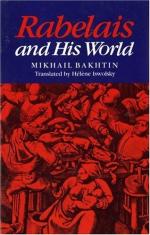
|
| Name: _________________________ | Period: ___________________ |
This test consists of 15 multiple choice questions and 5 short answer questions.
Multiple Choice Questions
1. Bakhtin generally finds Goethe's sense of Carnival's _____________ to agree with his own views.
(a) Universalism.
(b) Poetic expression.
(c) Pessimism.
(d) Religiousness.
2. Gargamelle gives birth to Gargantua as a result of:
(a) Casting a spell of birth.
(b) Eating too much tripe.
(c) A spirit impregnating her.
(d) Praying for a child.
3. In the example Schneegans offers, what does Rabelais' Friar John assert makes women fertile?
(a) Prayer to the protective saint of childbirth.
(b) The caress of a king.
(c) Eating a lot of tripe.
(d) The shadow of the abbey belfry
4. What is revealed in images of "negation"?
(a) The refusal of commitment between lovers.
(b) The destructive impulse of humanity.
(c) The harmful aspects of society.
(d) The opposition to the official world.
5. How does Bakhtin say Ivan the Terrible of Russia was similar to Rabelais?
(a) He also was a prolific and controversial writer.
(b) They both travelled anonymously to Carnival festivities.
(c) They both fought bloody battles against the reigning monarch.
(d) He too challenged old political and social structures.
6. What did the word "pantagruel" colloquially mean in the Renaissance?
(a) Foolish behavior caused by listening to fables.
(b) Hoarseness caused by drinking too much.
(c) Articles of clothing, made of harsh cloth, that cover the legs.
(d) A type of thin porridge eaten exclusively by the very poor.
7. To what are "swabs" most closely related?
(a) The material body lower stratum.
(b) The material body upper stratum.
(c) The liver and gallbladder's production of bile.
(d) The spiritual intellect's conversant function
8. What are the three categories of the "comic" which Bakhtin cites from Schneegans?
(a) The painted, the sketched, and the acted.
(b) The clownish, the burlesque, and the grotesque.
(c) The satiric, the clownish, and the visual.
(d) The grotesque, the ridiculous, and the satiric.
9. Bakhtin asserts that man introduces the world to himself primarily through which act?
(a) Observing nature.
(b) Sexual intercourse.
(c) Eating.
(d) Conversation.
10. What does Rabelais associate closely with the underworld?
(a) The depths of the human heart.
(b) Bodily depression after too much feasting.
(c) Mountains and ridges.
(d) Various types of holes.
11. How does Bakhtin define the combination of human and animal organs in Rabelais' novel?
(a) "Grotesque."
(b) "Scientific."
(c) "Horrifying."
(d) "Otherworldly."
12. According to Bakhtin, how did Rabelais invent many of the locales and characters in his novel?
(a) He wrote many letters asking friends for ideas.
(b) He traveled much and met many people.
(c) He abused drugs and wrote down his hallucinations.
(d) He rewrote stories from his childhood.
13. According to Schneegans, what is the grotesque in art?
(a) A caricature that has reached exaggerated dimensions.
(b) A representation of an otherworldly object.
(c) A portrait that has been defaced.
(d) A spoken-word performance involving violent acts.
14. What is the image of woman in the Renaissance popular comic tradition?
(a) Negative: woman is the source of all sin, and must be oppressed.
(b) Ambivalent: woman is degraded but simultaneously regenerative.
(c) Materialist: woman is worth money, in her body or from her work.
(d) Positive: woman is the light of the future, and must be celebrated.
15. In the Fourth Book, why does Villon set a trap for Tappecoue (or "Ticklepecker")?
(a) Tappecoue refused to lie to the king about Villon's sacrilege.
(b) Tappecoue refused to lend Villon vestments for his play.
(c) Tappecoue insulted Villon's family.
(d) Tappecoue stole a large sum of money from Villon.
Short Answer Questions
1. At the beginning of Chapter 6, Bakhtin argues that Rabelais' entire novel exhibits a clear, general __________ thematic trend.
2. How does Bakhtin define "folly" as it relates to festivity?
3. How does Bakhtin interpret Rabelais' work as a response to the hardships of France in 1532?
4. Bakhtin asserts that Rabelais' grotesque conception of the body reflected:
5. What does Rabelais parody in his response to the episode of Gargantua's birth?
|
This section contains 665 words (approx. 3 pages at 300 words per page) |

|




